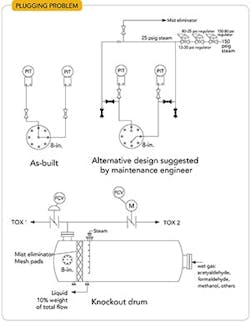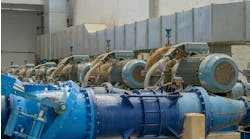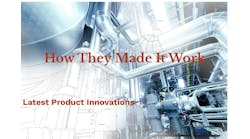This Month’s Puzzler
At one of our gas/oil separation stations, we have an old reciprocating compressor that operates with a knockout drum at the inlet. This past winter, it started giving us problems, which is strange because it has outlasted the centrifugal compressors at our other stations. The temperature gauges on the inner-stage coolers are showing a high temperature. The after-cooler for the product gas at the station also is running way too hot. We must ensure smooth operation before the high-demand winter season arrives.
Walking around the old compressor, I notice a lot of corrosion. I can’t read any of the equipment nameplates. Our data files are incomplete, compounding the problem if I must order a new compressor. I also see that one of the foundation anchor bolts is loose.
What do you think caused the problems with this old reliable unit? Do they relate to a seasonal factor or a capacity issue? Is it worth rebuilding the compressor or should we replace it — if so, how should I approach the replacement?
Delve Deeply
In summary, you have valve problems that would explain the elevated temperatures and vibration (loose anchor bolt).
The first step in troubleshooting is to ask the question “what has changed?” Unfortunately, not enough information has been given; all I can really do is ask questions:
Is the instrumentation on the knockout drum and compressor connected to a distributed control system or do you only have operator readings?
Has there been any change in gas flow rate, gas composition, suction and discharge pressures (apart from seasonal variations)?
You state the problem started in the winter, when the gas/oil ratio would be expected to drop. What sort of recycle piping and instrumentation do you have?
Have the problems continued when warmer weather returned?
How is the compressor driven? Has there been any change in the observed horsepower?
If steam driven, has there been any change in the steam condenser temperature and pressure?
Have the positions of the unloaders on the cylinders been changed?
I assume the compressor has its own lube oil reservoir and lube oil coolers. Is the condition of the lube oil regularly checked? Is the mechanical condition and cleanliness of the coolers regularly checked?
When was the last time the gas inner-coolers and aftercoolers were checked for cleanliness and mechanical condition?
Do you have enough instrumentation to allow the heat transfer coefficient to be calculated and tracked for these coolers?
What is the condition of your cooling water? Are the coolers on a backflush schedule?
Does the compressor have vibration instrumentation? If not, does your maintenance or reliability organization have portable vibration instrumentation that could be used?
How often in the past have the valves been replaced? When was the last time they were replaced? Was there any change to the manufacturer/model/metallurgy of the valves the last time they were replaced?
I wouldn’t recommend replacing the compressor if the only problem is that new valves are needed. If it turns out more extensive repairs are needed, you may want to consider scrapping and replacing the compressor but then you have to deal with your company’s capital funding procedure. This can be a lengthy process. And, then, there’s the long delivery time (typically 18–48 weeks) for a new compressor once your purchase order is issued. Can you do without your existing compressor for that length of time, or can you make do with your existing compressor’s performance for that length of time?
Getting vendor quotes for a replacement compressor is probably the easiest part of what I’ve described. Many companies require three bids as part of their capital budgetary process. Type up a list of your minimum, typical and maximum operating conditions (such as range of gas specific gravity, suction and discharge pressures, flow rates, any compounds requiring specific metallurgy such as H2S, and available utilities). Attach whatever standards regarding reciprocating compressors your company has. Some companies will require your purchasing group to go out for the bids, others will expect you to handle the bids. Be sure to check first if your company has an approved vendor list you must use.
Jim Jackson, project engineer
Sivalls, Inc., Odessa, Texas
It’s Fouling
Compressors fail for a lot of reasons: 1) particulates in the gas; 2) liquids in the feed; and 3) corrosion. Reciprocating compressors generally are more expensive but boast longer service life and lower maintenance than centrifugal compressors, which often are treated as throwaways. (This comparison resembles that between longer-life water-tube boilers and fire-tube boilers.)
Reciprocating compressors are less portable than centrifugal compressors; check the foundation to ensure it’s level and anchored.
The corrosion reported could be oozing from inside the compressor. So, try cleaning it up to see where it reappears.
Noise is important when assessing the health of either type of compressor. A noisy compressor indicates internal fouling or something worse like failing valve springs. Noise is more difficult to interpret; sometimes it’s extensive enough to show up as a vibration measurement but probably not.
The temperature gauges indicate some kind of fouling. There are three questions to answer: Why did this fouling suddenly show up? What is the cause of the fouling? And, has this fouling appeared on other compressors or equipment? It’s important to identify the source of the temperature rise before delicate internals like valve plates are damaged by the effects of high temperature.
Now, it’s time to consider exterior causes. Knockout drums and their internals, such as mist eliminators, are crucial in protecting the compressor and the heat exchangers cooling the stages from liquids in the form of aerosols. In addition, feedstock changes. As for solid particles, knockout drums can remove particulates but these tend to foul mist eliminators. Drums can take out liquids — including multi-phase liquids, and even solids — but they must be designed for it. Look at the drawings and get samples of what is being captured, not only in the drum but also in the mist eliminator. In addition, find out how long the other compressors are working without a trip to the repair shop; you may discover that something changed with the incoming gas that’s affecting all your compressors.
Dirk Willard, consultant
Wooster, Ohio
Figure 1. Impulse tubing for pressure transmitters on new knockout drum plugs frequently.
July’s Puzzler
We installed a new knockout drum with a better mist eliminator (Figure 1) to replace a drum that was giving us problems. The new drum, like its predecessor, is at the inlet of two thermal oxidizer (TOX) systems. “Flow is controlled by a pressure transmitter downstream of the mist eliminator,” notes the production foreman. Operations had project engineering install two redundant transmitters in the old drum. However, the impulse tubing for both transmitters plugged so often that the TOX systems downstream tripped on low pressure every few weeks. Those systems run at 2 psig at the inlet with the trips set at 0.5 psig. The pressure drop across the mist eliminator is about 0.3 psig when clean and about 0.5 psig when dirty, according to the manufacturer; our maintenance engineer says 0.75 psi is more like it. We installed two redundant transmitters on the new drum and their impulse lines also suffer from plugging: six months after the new drum was installed, the TOX systems have started tripping again.
Our grizzled, old maintenance engineer is disgusted. He hoped this problem would be solved by now. He says we should have included a steam purge in a manifold and the mist eliminator; he drew up a sketch in a few minutes when I asked his opinion on how to address the problem (see the figure). The young engineer who ran the project didn’t see a need for it, figuring the improved mist eliminator would do the trick.
What do you suggest to solve the problem? Why do you think the mist eliminator failed to work effectively to prevent fouling of the impulse tubing? Is there a better way to control the TOX systems or reduce trips? Is it possible to improve the performance of the mist eliminator?
Send us your comments, suggestions or solutions for this question by June 14, 2019. We’ll include as many of them as possible in the July 2019 issue and all on ChemicalProcessing.com. Send visuals — a sketch is fine. E-mail us at [email protected] or mail to Process Puzzler, Chemical Processing, 1501 E. Woodfield Rd., Suite 400N, Schaumburg, IL 60173. Fax: (630) 467-1120. Please include your name, title, location and company affiliation in the response.
And, of course, if you have a process problem you’d like to pose to our readers, send it along and we’ll be pleased to consider it for publication.



